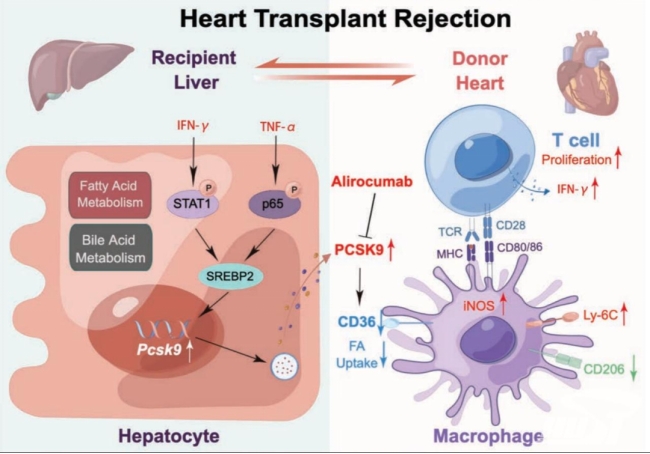The diligence and talents of HUSTers have led to plenty of latest breakthroughs in scientific research. Let’s have a look!
Prof. Xia Jiahong and his team’s research results on heart transplant were published in Circulation.

On May 26, Prof. Xia Jiahong and Prof. Wu Jie of the Cardiovascular Surgery Department of Union Hospital and their team published a research paper named Immune Regulation of the Liver Through the PCSK9/CD36 Pathway During Heart Transplant Rejection in the top international cardiovascular journal Circulation. The study reveals the new immune regulation mechanism for the first time, not only discovering a new target for the clinical diagnosis and treatment of HTR but leading a new way forward for the study of transplant immunology.
Link: http://news.hust.edu.cn/info/1003/48956.htm
Prof. Liu Yang and his team’s research results were published in Nature Materials.

On May 25th, a research paper titled Electro-thermal actuation in percolative ferroelectric polymer nanocomposites was published online in Nature Materials, which was jointly conducted by Prof. Liu Yang from the School of Materials Science and Engineering of HUST and Wang Qing from the Pennsylvania State University. This paper reveals the use of electro-thermal actuation to achieve high strain and mechanical energy density, which compares favorably with piezoelectric ceramics and crystals. Research briefing in Nature Materials also reports the main finding of this work entitled Polymer actuation using a Joule-heating-induced ferroelectric phase transition.
The study presents a paradigm shift for achieving large strain and ultrahigh elastic energy densities in ultralow electric fields in ferroelectric polymer composites for flexible electroactive devices and employs an electro-thermal approach to drive the ferroelectric phase transition in PVDF-based nanocomposites near the percolation.
Link: http://news.hust.edu.cn/info/1003/48847.htm
Prof. Ding Binbin’s team reported a new mechanism for the interactions of ER-LDs and enhancing LD biogenesis and lipolysis to reprogram lipid metabolism.

On May 23, Prof. Ding Binbin and his team from the Department of Biochemistry and Molecular Biology and the Center for Cell Architecture Research, School of Basic Medicine, published a research article entitled Coronaviral ORF6 protein mediates inter-organelle contacts and modulates host cell lipid flux for virus production in The EMBO Journal.
The study reveals how the coronavirus ORF6 protein modulates the interactions of ER-LDs and enhances LD biogenesis and lipolysis to reprogram lipid metabolism, serving as the theoretical basis and providing potential targets for the R&D of anti-virus drugs and peptamine.
Link: http://news.hust.edu.cn/info/1003/48824.htm
Prof. Wang Chengliang and his team synthesized single crystals of a highly conductive 3D CCP.

On May 19, JACS published a research article titled Single Crystals of a Highly Conductive Three-Dimensional Conjugated Coordination Polymer by Prof. Wang Chengliang and his team from the School of Integrated Circuits.
Conjugated coordination polymers (CCPs), which possess long-range planar π–d conjugation, are fascinating for various applications because they inherit the merits of both metal–organic frameworks (MOFs) and conducting polymers. However, only one-dimensional (1D) and two-dimensional (2D) CCPs have been reported so far. The synthesis of three-dimensional (3D) CCPs is challenging and even seems theoretically infeasible. The study reports the first 3D CCP and its single crystals with atomically precise structures.
Link: http://news.hust.edu.cn/info/1003/48793.htm
Prof. Zhang Xinliang and his team made breakthroughs in real-time Fourier-domain optical vector oscilloscope.

On May 5, a research article entitled Real-time Fourier-domain optical vector oscilloscope by Prof. Zhang Xinliang and his team from Wuhan National Laboratory for Optoelectronics was published in Science Advances. The study demonstrates a large bandwidth (~3.4 THz) real-time optical vector oscilloscope, which obtains the full-field spectrum through the advanced modulation formats, representing significance in advanced optical communication systems and the application of wavelength division multiplexing systems.
Link: http://news.hust.edu.cn/info/1002/48708.htm
The team led by Prof. Lu Peixiang and Prof. Wang Bing made significant headway in photonic Floquet Landau-Zener tunneling and temporal beam splitters.

On May 3, Science Advances published a research article online entitled Photonic Floquet Landau-Zener tunneling and temporal beam splitters by Prof. Wang Bing from the Ultrafast Optics Laboratory of the School of Physics. The study finds versatile applications in reconfigurable beam splitters and encoders.
Link://news.hust.edu.cn/info/1003/48606.htm
The team led by Prof. You Bo and Prof. Xia Baoyu made new progress in Sn-based electrocatalysts for CO2 reduction.

On May 2, a research paper titled Simultaneous Generation of H2O2 and Formate by Co-Electrolysis of Water and CO2 over Bifunctional Zn/SnO2 Nanodots co-authored by Prof. You Bo and Prof. Xia Baoyu from the School of Chemistry and Chemical Engineering, HUST and Prof. Liu Jinlong from Central South University, was published on Angewandte Chemie International Edition.
The electrocatalytic reduction of CO2 into value-added chemicals and fuels is a promising approach to achieving carbon peaking and carbon neutrality goals. But the selectivity and activity of catalysts still need to be improved. The study reports the development of a novel hybrid electrosynthesis system and provides new ideas for the design of bifunctional redox electrocatalysts, which can be extended to other electrochemical reactions to achieve efficient co-production of high value-added chemicals.
Link: //news.hust.edu.cn/info/1003/48672.htm
Written by: Qin Wei
Edited by: Yang Kunjie, Chang Wen, Peng Yumeng
